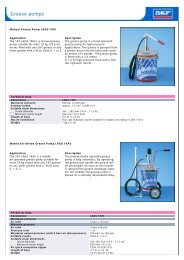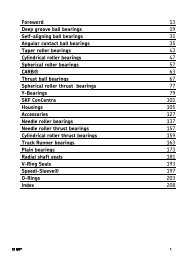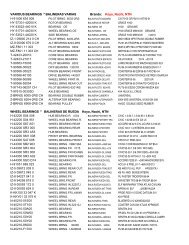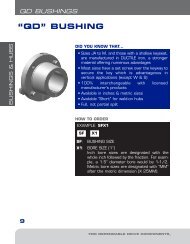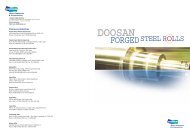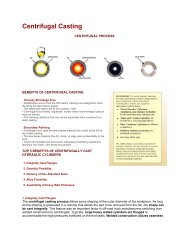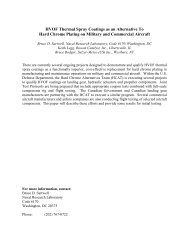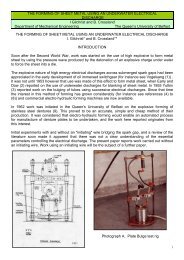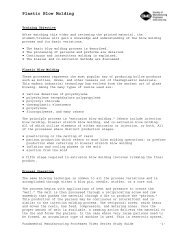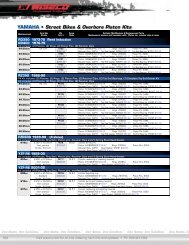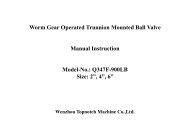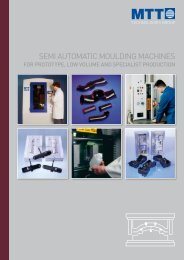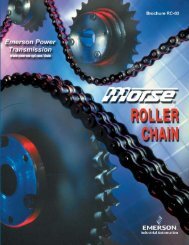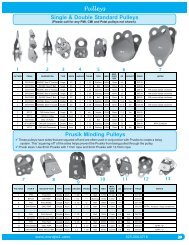Sepor's Batch Ball/Rod Mill Drive
Sepor's Batch Ball/Rod Mill Drive
Sepor's Batch Ball/Rod Mill Drive
You also want an ePaper? Increase the reach of your titles
YUMPU automatically turns print PDFs into web optimized ePapers that Google loves.
SEPOR, INC.<br />
718 N. FRIES AVE.<br />
P. O. BOX 578<br />
WILMINGTON, 90748<br />
PHONE: 310-830-6601<br />
FAX: 310-830-9336<br />
Web Site: http://www/sepor.com<br />
<strong>Sepor's</strong> <strong>Batch</strong> <strong>Ball</strong>/<strong>Rod</strong> <strong>Mill</strong> <strong>Drive</strong><br />
<strong>Sepor's</strong> 5 Series <strong>Batch</strong> <strong>Ball</strong> and <strong>Rod</strong> <strong>Mill</strong> <strong>Drive</strong> is a rugged, heavy duty mill drive especially<br />
suited for steel grinding jars, or large porcelain grinding jars (5 gallon size). The drive<br />
mechanism is a 1/2 HP gear motor with a variable speed, capable of roll speeds between<br />
40 RPM's and 230 RPM's. The rolls are 5 inches in diameter by 24 inches long, covered<br />
with rubber, set on 10 inch centers. A work shelf and built in ball discharge grate is contained<br />
on one end of the mill frame.<br />
CATALOG SHIPPING DIMENSIONS<br />
NUMBER DESCRIPTION NO. ROLLS WT. LBS. L,H,W (IN.)<br />
010E-001 <strong>Drive</strong> Roll, 110 V/1 Ph/60 Hz 2 250 43" x 33" x 30"<br />
<strong>Drive</strong> Roll, 220 V/1 Ph/50 Hz 2 250 43" x 33" x 30"<br />
010E-002 <strong>Drive</strong> Roll, 110 V/1 Ph/60 Hz 3 300 43" x 33" x 30"<br />
<strong>Drive</strong> ROll, 220 V/1 Ph/50 Hz 3 300 43" x 33" x 30"<br />
010E-003 <strong>Drive</strong> Roll, 110 V/1 Ph/60 Hz 4 350 43" x 33" x 30"<br />
Drove Roll, 220 V/1 Ph/50 Hz 4 350 43" x 33" x 30"<br />
Specify Voltage, 110 V or 220 V when ordering
Table of Grinding Jar, Roll Speeds for 5" Diameter<br />
Roll <strong>Drive</strong><br />
GRINDING JAR JAR GRINDING SPEED, @ 75% DRIVE ROLL SPEED REQUIRED TO OBTAIN<br />
DIAMETER CRITICAL SPEED JAR GRINDING SPEED<br />
(INCHES) (RPM’S) (RPM’S)<br />
8.0 70 113<br />
9.0 66 119<br />
10.0 63 126<br />
11.0 60 132<br />
12.0 57 138<br />
13.0 55 144<br />
14.0 53 149<br />
Grinding Media<br />
Generally, steel grinding balls are used with steel mills, ceramic balls are used with porcelain or ceramic<br />
lined mills and steel, ceramic, or other high density media is used with elastomer lined mills. Porcelain balls<br />
have a SG of 2.3 and have a average weight/volume of 12.8 pounds per gallon. High density alumina (ceramic)<br />
balls have a SG of 3.2 and have an average weight/volume of 17.5 pounds per gallon. Steel balls have a SG of<br />
7.7 and have an average weight/volume of 40 pounds/gallon.<br />
Higher density grinding media generally results in faster grinding in a ball mill. An optimum grinding<br />
charge for a ball mill is approximately 50% of the mill volume, or to the center line. However experimentation will<br />
determine the best grinding charge for a given application. Generally, the grinding charge will be in the range<br />
of 30% to 50% of the mill volume. Approximately 30-40% of the ball charge will be void space.<br />
Dry Grinding<br />
Material loads for ball mill dry grinding generally fall into the 25% to 50% of the mill volume range. If the<br />
mill is loaded with a 50% grinding charge and a 50% ball charge, it will not be 100% full, since approximately<br />
30% of the ball volume is void space. Some experimentation will be required to obtain the proper mill charge<br />
for the most efficient grinding for various materials. If the mill is overloaded, it may not be possible to obtain<br />
fine particle sizes by grinding and the mill grinding efficiency decreases exponentially, as the grinding time<br />
increases exponentially. Therefore, mill overloading should be avoided.<br />
Wet Grinding<br />
Material loads for ball mill wet grinding generally fall into the 30% to 50% of the mill volume range. The<br />
slurry could range from 30% to 60% solids by weight.. Some experimentation will be required to obtain the<br />
proper mill charge for the most efficient grinding for various materials. If the mill is overloaded, it may not be<br />
possible to obtain fine particle sizes by grinding and the mill grinding efficiency decreases exponential, as the<br />
grinding time increases exponentially. Therefore, mill overloading should be avoided.<br />
Sepor has laboratory size grinding ball mills in a variety of materials of construction, including carbon<br />
steel, stainless steel, urethane lined, porcelain, and ceramic. Our grinding media includes balls, cylinders and<br />
rods (for rod mills). Materials of construction include carbon steel, stainless steel, chrome steel, flint pebbles,<br />
porcelain, ceramic, and zirconia. Most grinding media is available in a variety of sizes to suit many grinding<br />
applications.<br />
2
General Grinding Information For <strong>Ball</strong> <strong>Mill</strong>s<br />
Grinding Media<br />
Generally, steel grinding balls are used with steel mills, ceramic balls are used with<br />
porcelain or ceramic lined mills and steel, ceramic, or other high density media is used with<br />
elastomer lined mills. Porcelain balls have a SG of 2.3 and have a average weight/volume<br />
of 12.8 pounds per gallon. High density alumina (ceramic) balls have a SG of 3.2 and have<br />
an average weight/volume of 17.5 pounds per gallon. Steel balls have a SG of 7.7 and have<br />
an average weight/volume of 40 pounds/gallon.<br />
Higher density grinding media generally results in faster grinding in a ball mill. An optimum<br />
grinding charge for a ball mill is approximately 50% of the mill volume, or to the center<br />
line. Approximately 30-40% of the ball charge will be void space.<br />
Dry Grinding<br />
Material loads for ball mill dry grinding generally fall into the 25% to 50% of the mill<br />
volume range. If the mill is loaded with a 50% grinding charge and a 50% ball charge, it will<br />
not be 100% full, since approximately 30% of the ball volume is void space. Some experimentation<br />
will be required to obtain the proper mill charge for the most efficient grinding for<br />
various materials. If the mill is overloaded, it may not be possible to obtain fine particle<br />
sizes by grinding and the mill grinding efficiency decreases exponentially, as the grinding<br />
time increases exponentially. Therefore, mill overloading should be avoided.<br />
Wet Grinding<br />
Material loads for ball mill wet grinding generally fall into the 30% to 50% of the mill<br />
volume range. The slurry could range from 30% to 60% solids by weight.. Some experimentation<br />
will be required to obtain the proper mill charge for the most efficient grinding for<br />
various materials. If the mill is overloaded, it may not be possible to obtain fine particle<br />
sizes by grinding and the mill grinding efficiency decreases exponential, as the grinding time<br />
increases exponentially. Therefore, mill overloading should be avoided.<br />
Sepor has laboratory size grinding ball mills in a variety of materials of construction,<br />
including carbon steel, stainless steel, urethane lined, porcelain, and ceramic. Our grinding<br />
media includes balls, cylinders and rods (for rod mills). Materials of construction include<br />
carbon steel, stainless steel, chrome steel, flint pebbles, porcelain, ceramic, and zirconia.<br />
Most grinding media is available in a variety of sizes to suit many grinding applications.



